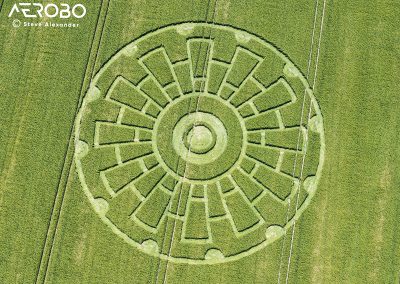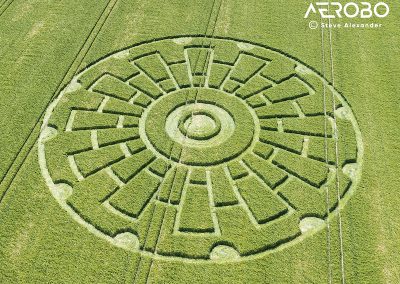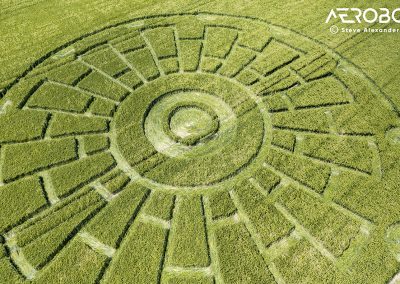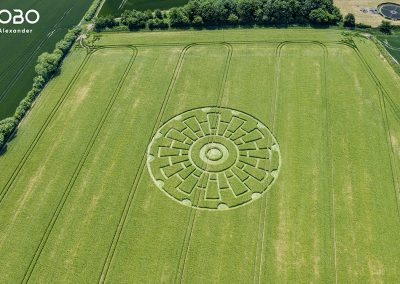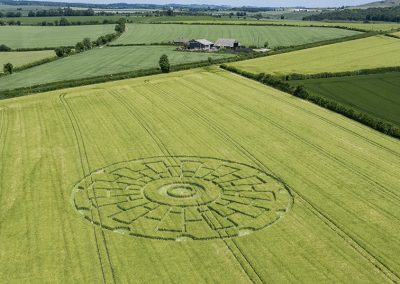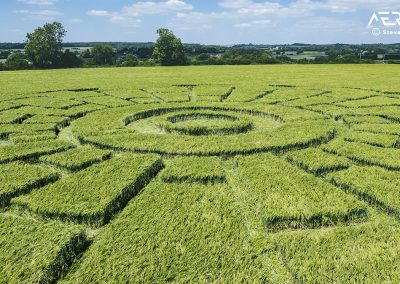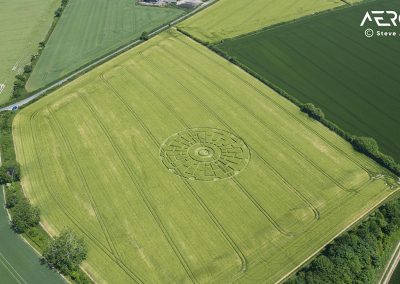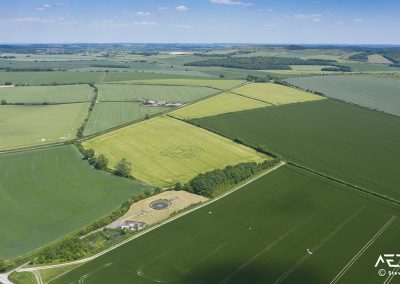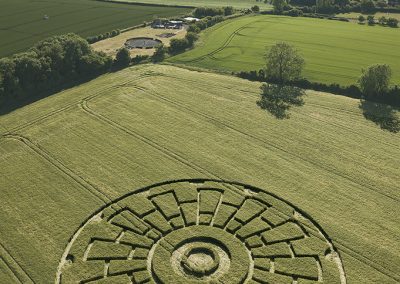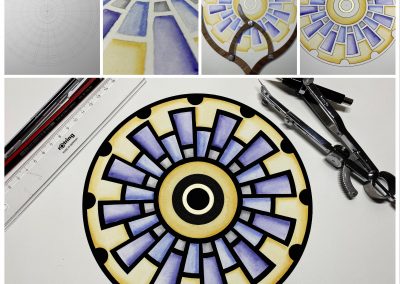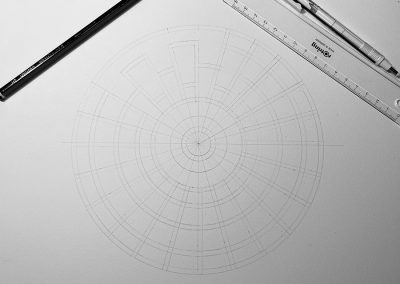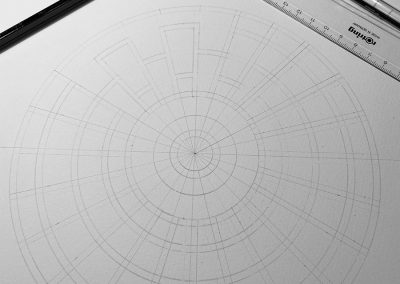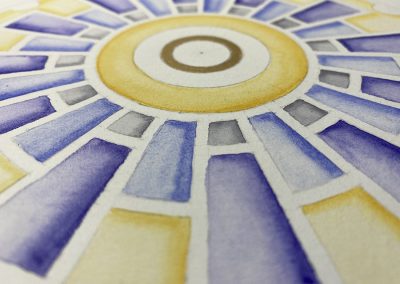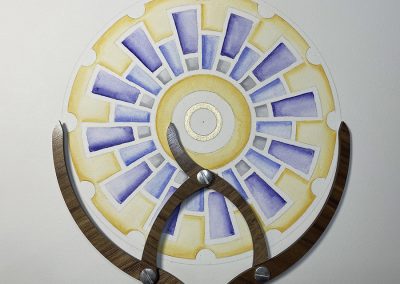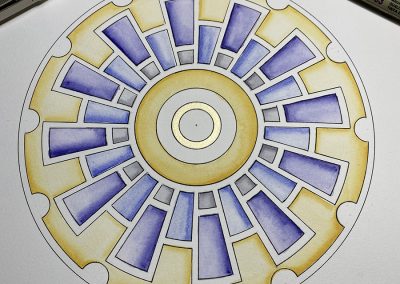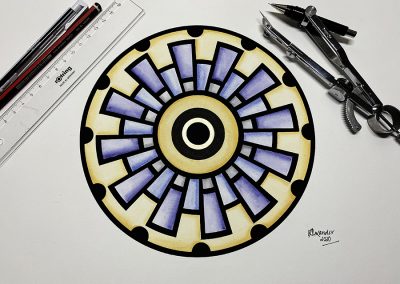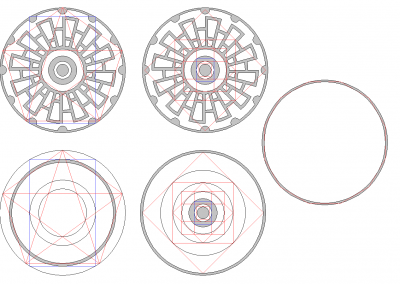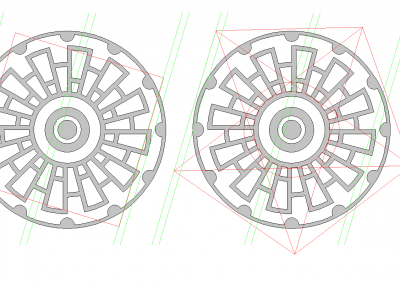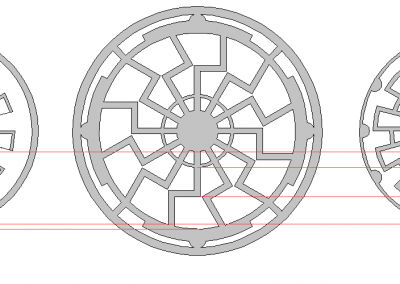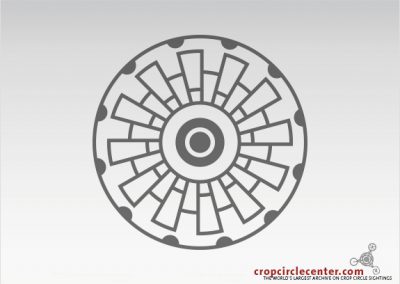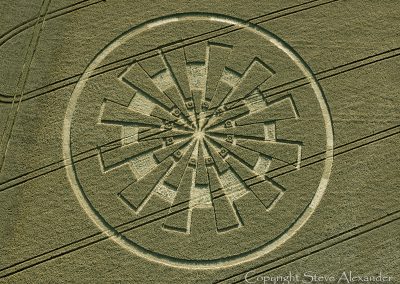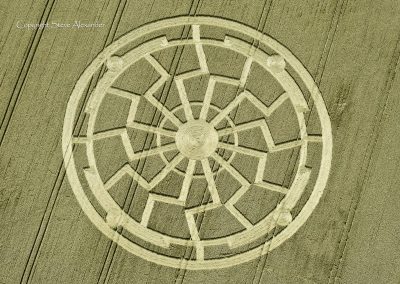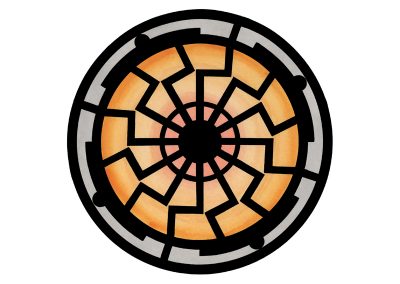Sixpenny Handley, Dorset.
(between Salisbury and Blandford Forum)
Detail & Location: This circle was reported on the 31st of May. It is in a field of green barley and measures approximately 200ft in diameter. See the Google Maps link for precise location. It is the most complex formation of the 2020 season so far.
Crop Circle Reporting and Covid-19: After considerable thought and consultation, we have decided we will not be censoring crop circle locations during the Covid-19 pandemic. There are no current restrictions in place in the UK that call for a blanket ban on visiting the countryside. We consider the reporting of crop circles to be in the spirit of journalism, and censorship to be an anathema to that spirit. Therefore, we will be treating the crop circle community as adults and asking everyone to approach the information carefully and responsibly. This will include not visiting the circles if the farmer has not given explicit permission to do so and should permission be given that they practice social distancing by staying 2 metres away from fellow visitors. It would be our very strong advice that visiting the crop circles on the ground should be kept to an absolute minimum for now. However, because we know that the location of any given circle can be important to researchers and those that record the circles from the air, we will continue to share what we know.
Flying during the Covid-19 Pandemic: As yet, because of the current pandemic, we have not been able to take to the air to record the crop circles as we usually would. We are however, very confident that the restrictions keeping us grounded at present will be lifted before too long and we will be able to cover the rest of the season as usual. In the meantime, we are every pleased to have teamed up with the excellent AEROBO (Art in Flight) who will be helping us collect images and drone footage of the latest crop circles to share on the website.
Visiting: As far as we are aware no permission has been given to visit this crop circle. Please do not visit this circle. Thank you.
History & Connections: Sixpenny Handley has been the site of several formations in the last 10 years. There are several ancient earth works in the area including an unfinished hillfort near the prettily-named Mistleberry Wood. It’s a beautiful location with much open farmland.
Design & Symbolism: The circle is essentially 12-fold – although you can clearly see from the pictures that a division by 24 is necessary to construct the pattern. It’s clock, or wheel-like appearance is interesting as 12 is a number intimately connected with time and measure.
See the Geometry section further down the page for a full write-up on this circle, its geometry and symbolism.
Visiting the Circles? If you are thinking of visiting any crop circles this summer, please read our Visiting the Crop Circles section. It’s full of useful information and etiquette for visiting the countryside and the crop circles. Please remember that you should not enter any fields without the express permission of the farmer and you will need to be aware of and abide by any restrictions in place in the UK in response to the Covid-19 pandemic.
Click here for Copyright Information about the reproduction of images on this website.
Please Help to keep us Flying in 2019: If you have enjoyed looking at our pictures and information please consider making a small donation to keep us flying. There are so few of us left regularly recording the circles it’s really important that we continue. And while some now use drones to record the circles, it is important that there are still images taken from aircraft where the best quality camera equipment can be used and images that include the broad vista of the landscape can be taken. This kind of photography is expensive and it gets harder with each passing year to raise the funds we need to continue our work, but if everyone who regularly looked at this website made a small donation we would meet the funds we need. You can make a donation here.
NOTE: Some of the images below are beautiful landscape scenes. Click on each image to enlarge them and see the whole picture.
Aerial Footage Coming Soon…
Image Licencing
We can supply high resolution images of many of our photographs and the sky is the limit as to what they can be used for! Choose from our extensive library or contact us to commission aerial photography for your project.
Geometry Gallery
The Flower Piano
By Karen Alexander
The quest for answers is a journey, not just a quick Google search
In this world of social media, Google, Alexa, Siri and many others we are becoming ever more used to having the answer to our every query at our fingertips. On the one hand, this is terribly useful, utilitarian, and efficient, on the other hand it sets us up to fail in that we no longer seem to have the time to properly research, explore or consider before offering something for others to look at. The crop circles are no different, the race to get the first picture (no matter the quality), the first to offer the ‘solution’ to the ‘code’ is deeply depressing. We put ourselves under so much pressure, because we know in these days of instantaneity that by the time we have taken the time to offer something thoughtful and considered, the whole world has moved onto the next thing, the next crop circle, the ones that came before are forgotten, consigned to the ‘solved’ or ‘shrug’ file, or more alarmingly the trash.
I have always considered that the crop circles were in part some kind of antidote to our increasingly frenetic and stressed thinking, something that required we just stopped and looked, really looked. Something we took time over. The whole essence of a mystery is that it arrests consciousness and expands it elsewhere, that our quest for answers is a journey, not just a quick Google search.
The human hand connected to the human heart
At the moment I don’t use a CAD or illustrator programme to the draw the circles, although this is about to change and I am for the first time taking a foray into that digital world. I can see its undoubted efficacy, quickness and convenience (once you’ve learned to do it!), but I won’t be giving up drawing by hand anytime soon. That celebrated architect and self-proclaimed ‘seeker of patterns’ Keith Critchlow once said that geometry is best drawn ‘with the human hand connected to the human heart’ and that the simple compass was the best scientific instrument ever invented by man. Needless to say I admire his sentiments hugely, because drawing is not just a means to an end, it is a journey, and a physical, mental and spiritual one at that. It is experiential in a way that is very hard to describe, the careful, steady drawing of geometry has a rhythm of its own, its like a dance with your hands instead of your feet. It also affords time to think, time for the task to consume your attention, for you to get out of your own way and engage the more subtle senses as part of your exploration.
Drawing the Sixpenny Handley formation
I took about a week drawing and painting the Sixpenny Handley formation. Time in which I could allow the formation to work its magic on me, for it to soak into my psyche, for me to feel like I really knew it. Like Goethe’s ‘Urpflanze’ (the archetypal plant), I am always looking for the essence of the phenomenon in each circle that I study, in the process of which I am happy to give myself over to it for a while, to ‘attend’ it, to give it my full and undistracted attention.
This does not sit well in the world, where to be first has become somehow equivalent with the entitlement to say you are right. How on earth did we arrive here? When did he who shouts first, or loudest, become the only legitimate bearer of truth? Perhaps I should state that this is a rhetorical question, I do not want to burden you, dear reader, with such a HUGE question - so sorry!
A dream about a Flower Piano
During the week that I was working on my drawing/painting I had a dream abut the crop circle. Sometimes this happens, they just get under your skin. During that week I had also been listening to Beethoven as I drew, specifically his piano concertos and sonatas. I hadn’t heard them in a while and they always take me back to childhood, when my parents would play a lot of classical music in our home. In addition I had also been dipping in and out of Keith Critchlow’s fabulous book ‘The Hidden Geometry of Flowers’ - another childhood pastime of mine was spotting and identifying wild flowers. You might call it a perfect storm of refection and edification out of which this dream was born.
In the dream the crop circle is a circular keyboard (like a piano) and I am playing it with my mind, I don’t recall the sound of the music, but it was an immensely amazing experience to play music in this way. I was told, by the provider of the instrument (who was unknown and unseen by me in the in the dream) that this was a Flower Piano. I thought it a beautiful name for a beautiful instrument. That was essentially all there was to the dream.
At first I put this down to all of the things I described above, spending considerable time with this crop circle design, listening to Beethoven’s piano compositions and reading about the geometry of flowers, in other words as a consolidation of my intense activity seeping into my psyche. But when I shared this dream with some fellow researchers, I was told immediately that this circle could in fact be a representation of a keyboard.
Twelve, Twenty-four and number in time
Drawing this formation begins with dividing the 360º of the circle into twenty-four equal sectors (the formation itself is essentially 12-fold in design).
Twelve and twenty-four are numbers associated with measure, with time and with the wholeness of the two. Twelve is sometimes seen as the optimum way to divide a circle, and many traditional designs use twelve as their base number. As I have discussed many time on this website the relationship twelve has to measure and time are found in the imperial measurement system, the hours in a day and the months in the year. Our ancestors divided the heavens into twelve zodiacal constellations. With just these few things, it easy to see how these associations were made. All of them tie together with the circle, the symbol of perfect unity. The imperial measure system, time of day and time of the year, and the great year are linked by 12 and the circle. They create a unity of system, in other words a ‘unified system of time and measure’. In this way, we become aligned with the Cosmos.
Twelve and twenty-four are also numbers associated with music, there are 12 major keys and 12 minor keys. Music is number (or geometry) in time. It uses many of the proportions and ratios we have all become familiar with - many of them used in crop circle designs for the past 30 years at least. But as I discovered, in order to make all these alignments and symmetry, some compromise is needed.
The Pythagorean Comma
In the development of western music it was at some point decided that there needed to be a unity of pitch, so that all instruments could play the same music whatever instrument they played. This was achieved by agreeing to something called ‘Equal Temperament’ we now used a 12-tone equal temperament to divide the frequencies of the musical sale ensuring a symmetry throughout the system. However, in nature the musical frequencies are not so tidy, they are not all evenly tempered. This leads to something called the Pythagorean comma. This is best envisaged as a 12 pointed star in which one of the points of the star does not quite meet up to close the system perfectly. This gap is the comma.
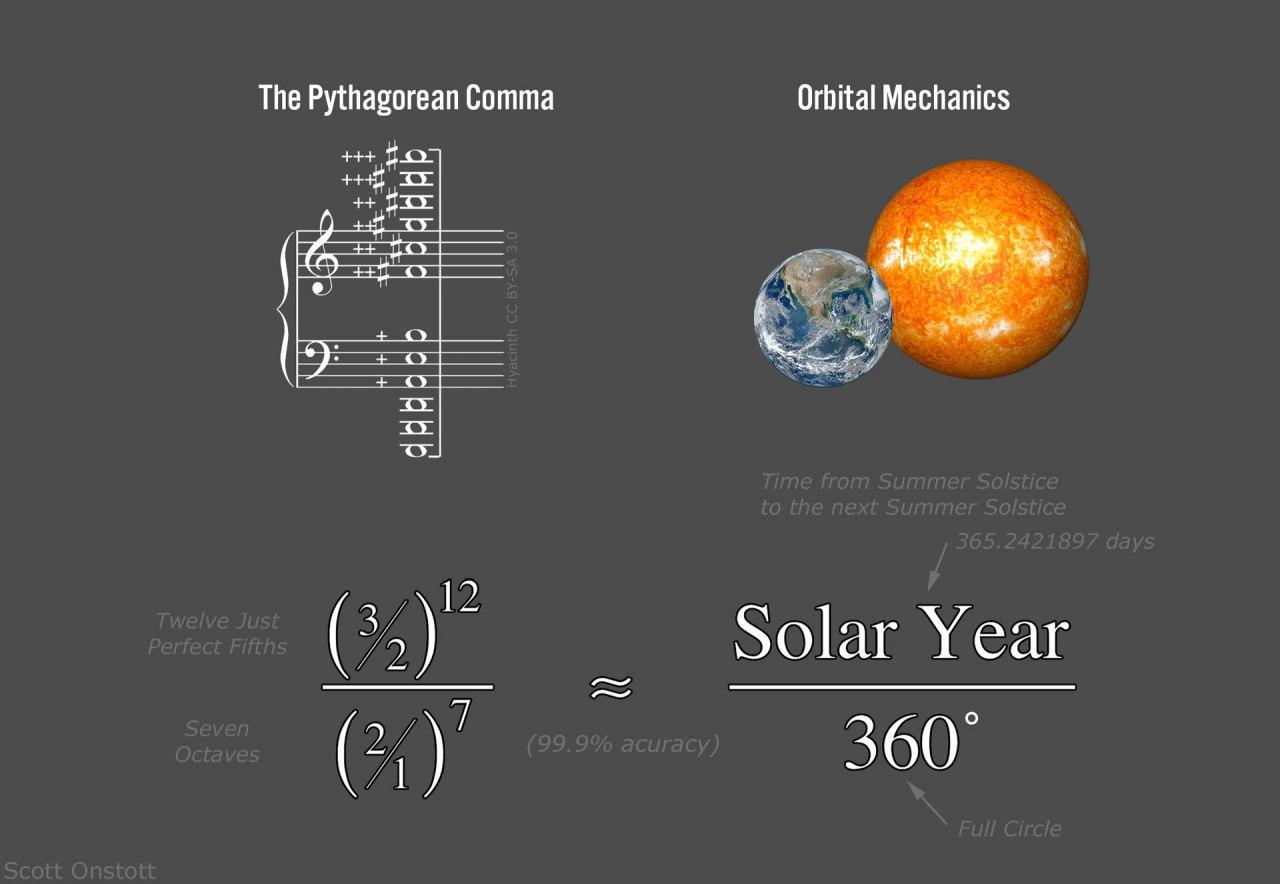
Pythagorean Comma and the Solar Year - by Scott Onstott
The geometer Scott Onstott has shown that the sum of the Pythagorean comma has the same ratio as the solar year of 365.242 days is to a full circle of 360 degrees. This gap, it seems, exists throughout the cosmos on different scales.
While the crop circle does not allude to the comma itself, if one does interpret it as a musical instrument, then it does seem to show equal temperament. What is important here, is not so much the technicality of the way in which music is intoned, but more the idea behind it. The meaning behind the metaphor (or symbol).
One does not have to be perfect to be whole
What is exemplified by the Pythagorean comma is that there is a difference between the ideal world of perfect symmetry and manifestation of things in the material world. As any geometer who has ever spent much time drawing by hand will know, from the first mark you make on the paper, you introduce a level of error to your construction. The more complex the construction becomes the more any error, no matter how small, is compounded. Margins of error are a humbling concept to anyone who aims for perfection. As your drawing progresses, one may be forced to make adjustments at various stages to keep the construction stable, aligned and symmetrical. A version of this is used in equal temperament where the notes are artificially adjusted to equally regular ratios to keep the system universal. As my colleague Jonathan-Paul DeVierville reminded me, one does not have to be perfect to be whole.
Conclusions
This circle could be interpreted in many different ways, my dream is just one. But I take several meanings away from my time with this crop circle. The first is the ever-present difference between the ideal world of forms and then their manifestation in the material world. In the dream (a non physical realm), I played the instrument with my mind, the interface was flawless, entirely symbolic of the archetypal and perfect non-physical realm. Plato’s realm of the ‘Forms’ - if you will.
However, the crop circle itself needed to employ ‘Equal Temperament’ to compensate for the margins of error in pitch that are a natural consequence of being manifested in the dense realms of physical reality. For something to transfer from a non-physical world of ideas and consciousness to the dense physical realm of atoms, molecules and materiality, there is a natural loss. There is a ‘Fall’ if you like, after which some re-attunement, some accommodation, a reconciliation maybe required in order for the pure idea to meet its newly clothed-form in the material world.
Just perceptible in the peripheral vision of my thinking is a glimpse into something about the nature of the crop circle phenomenon itself. Perhaps the crop circles too, have to make this journey (or take this Fall) from some unknown realm into our 3D reality? Perhaps they are revealing something important about the nature of what that journey entails.
Thanks & Credits
This article would not have been possible without the generous help of a handful of very important people. I would like to thank some of my crop circle cognoscenti for their help in forming these ideas.
Steve Alexander, Todd Hayen, Jonathan DeVierville, Scott Onstott, Albert Lamb, Peter van den Burg, Veronica Goodchild, Geoff Fitzpatrick & Judy Cox.
Text | Hand-drawn Images by Karen Alexander.
With special thanks to Peter van de Burg for his thoughts, perspectives and analysis. You can see more of his great work on his Facebook page Geometry of the crop circles.
Golden Section Proportioners by Scott Onstott.
Diagram by Bertold Zugelder.
Further Thoughts
This crop circle has been compared to two others. The first is to the so-called "Black Sun' circle at Bowerchalke in 2015 and the other being the Temple Farm (Rockley) circle of 2011. Peter van den Burg has dawn a useful comparison between them in the gallery below.
The Temple Farm circle was calendrical in nature and encoded its date of arrival in its geometry. The Bowerchalke circle of 2015 remains controversial for its use of a symbol popularly associated with Nazism - although as with so many symbols appropriated at that time, its origin is much, much older. You can read my blog article about the Bowerchalke circle here.
Thoughts on Sixpenny Handley by Peter van den Burg (see his diagrams in the gallery below).
Some parts come forth from a Golden rectangle (blue) and pentagonal proportions, other parts flow straight from an √2 template. But they are like water and oil, they won't blend easily. The outer ring is based on the inner- and outer radius of a regular dodecagon or twelve fold regular polygon.
When the tramlines throw inn a Squared circle it only adds to the feeling of incoherency since that too doesn't fit in any of the two templates.
The small blue rectangle placed in the square template is a √ɸ rectangle and seems to only place where the two are cooperative.
If it can't be explained simple, it is probably not well understood. I feel that is the case for me here. I hope to come back to this one later on. It is suggested that the formation is akin to the Bowerchalke black sun (2015), and Rockley (2011). I would like to add that it is not only in design they are related but allso in size.
One wonders if there is a sett of rules that determines size in relation to design?
Date
31.05.2020
Crop
Barley
Visiting
No permission has been given to enter this circle.
Google Maps Link


